This post contains affiliate links. Click here to read my affiliate policy.
Last Updated on December 17, 2023
Have you ever tasted mochi? It’s a small Japanese rice cake known for its sticky, chewy texture and variety of delicious fillings. Imagine that texture as a donut, and you have a mochi donut!
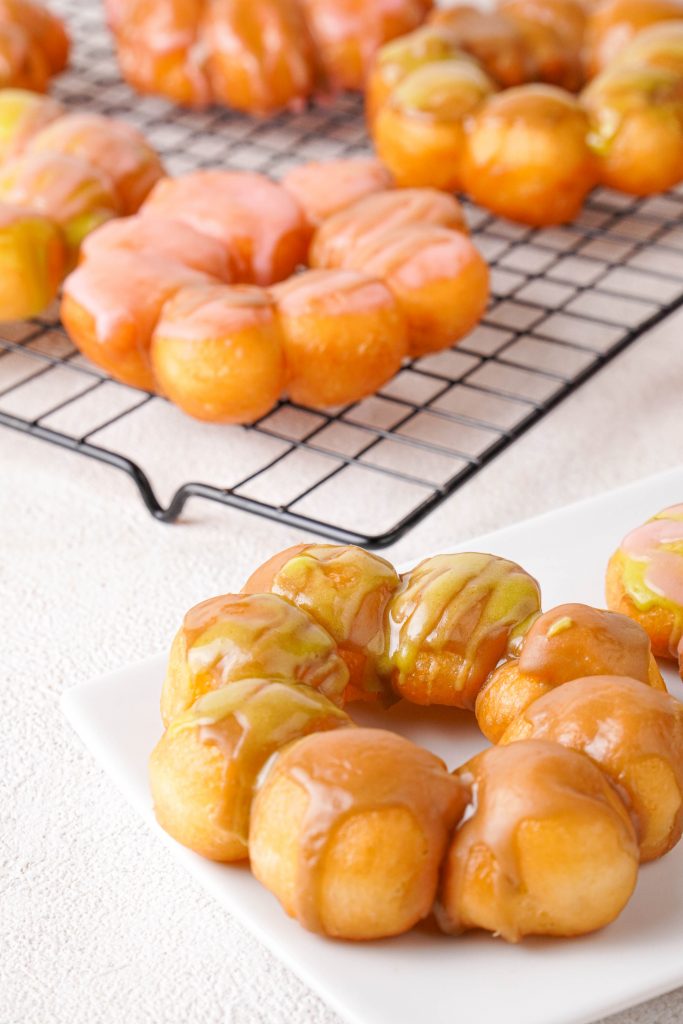
If you’re craving mochi donuts at home or are curious about what this trendy dessert tastes like, I’ll be sharing a matcha mochi donuts recipe that you can easily make in your kitchen! Plus, I’ll show you two ways to form them: the dough ball version and the popular Pon de Ring version.
The best part about this recipe is that you don’t need an oven. Many recipes bake the dough, but we’ll be frying mochi donuts for your convenience. So, keep reading to learn how to make this quick and easy treat at home.
Ingredients
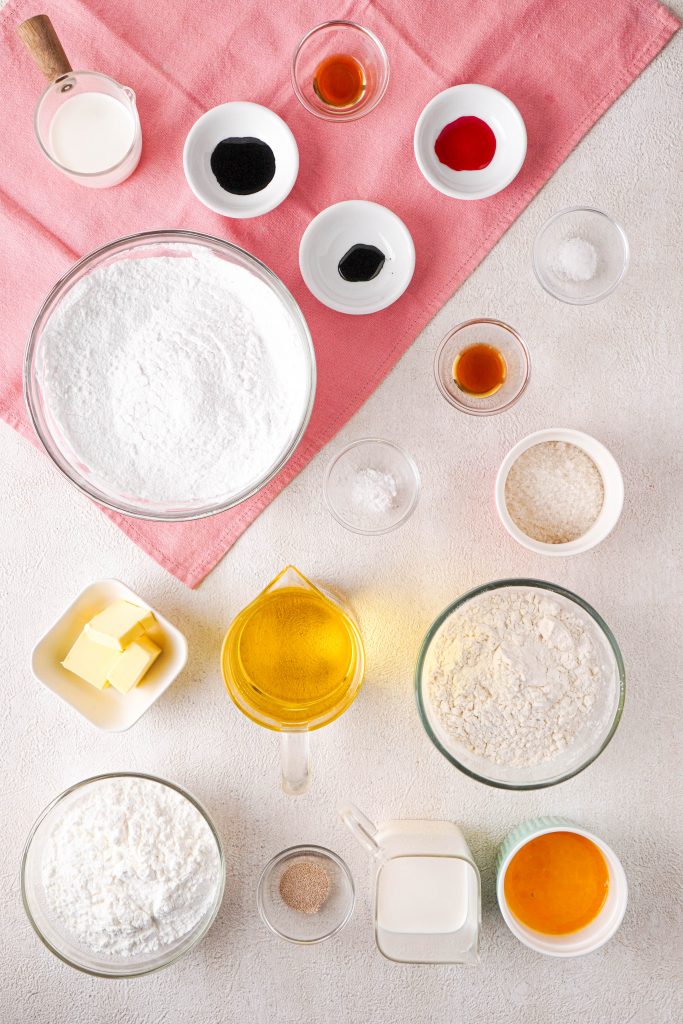
Starter Dough
- ¼ cup glutinous rice flour
- 2 tbsp whole milk*
Main Donut Dough
- 1¾ cups glutinous rice flour
- ½ cup whole milk*, plus more as needed
- 2½ tbsp unsalted butter, melted
- ¼ cup granulated sugar
- 1 large egg
- 1 tsp baking powder
- 1 tsp Matcha powder
*You can try switching the whole milk to almond milk or other plant-based alternatives for a vegan-friendly version. You may also use warm or room temperature milk.
Dusting
- ¼ cup powdered sugar
- 1½ tsp Matcha powder
This recipe tops off the donuts with a sprinkle of sugar and matcha powder, making it easy to do at home. However, many recipes use a glaze for that extra sweetness and aesthetics. So, I’ll add this tasty matcha glaze recipe if you want to try it.
Matcha Glaze
- 1½ cups confectioners’ sugar
- 1 tbsp matcha powder
- 1 tsp lemon juice
- ½ tsp vanilla extract
- 3 to 4 tbsp whole milk, plus more as needed
Feel free to use either topping according to your preference or available ingredients.
How to Make Matcha Mochi Donuts
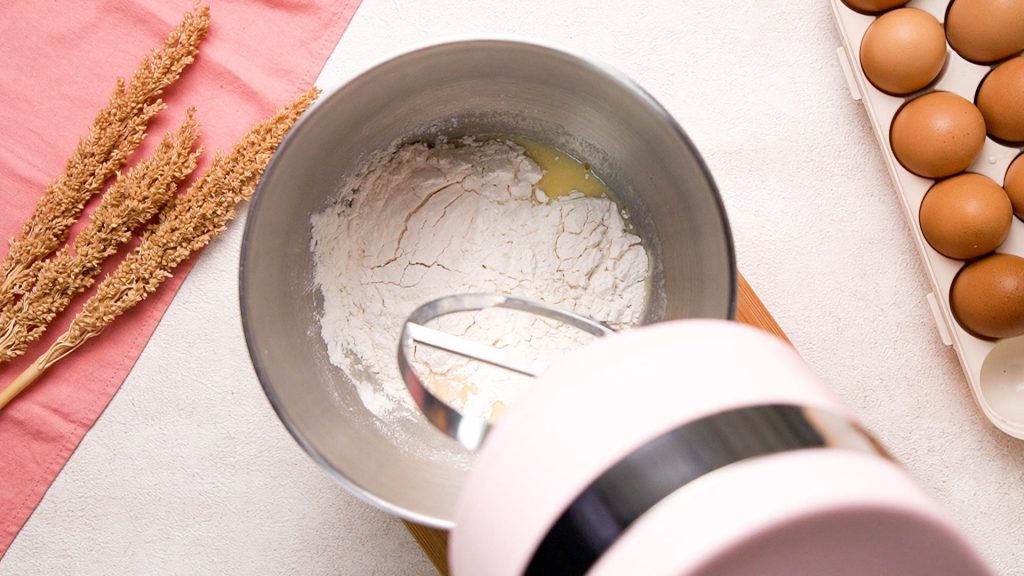
1. Make the Starter Dough
You want to start by getting a microwavable bowl and mixing the glutinous rice flour and whole milk. Give it a good stir, and heat it in the microwave on a high setting for 30 seconds.
Once that’s done, stir it quickly, and put it back in the microwave for another 15 to 20 seconds. This ensures that it’s cooked thoroughly and you don’t end up with the raw dough. You’ll know it’s done when the dough looks opaque and feels firm but bouncy. Set it aside, and let it cool for a while.
If you don’t have a microwave, don’t worry! Some recipes make the starter dough on a stovetop. To do this, get a saucepan and place it on a stove on high heat. Then, stir your milk and glutinous rice flour in the saucepan.
Mix it on the stove until you have one lump of mass. Just like with the microwave technique, your dough is ready when it’s opaque and firm but bouncy to the touch.
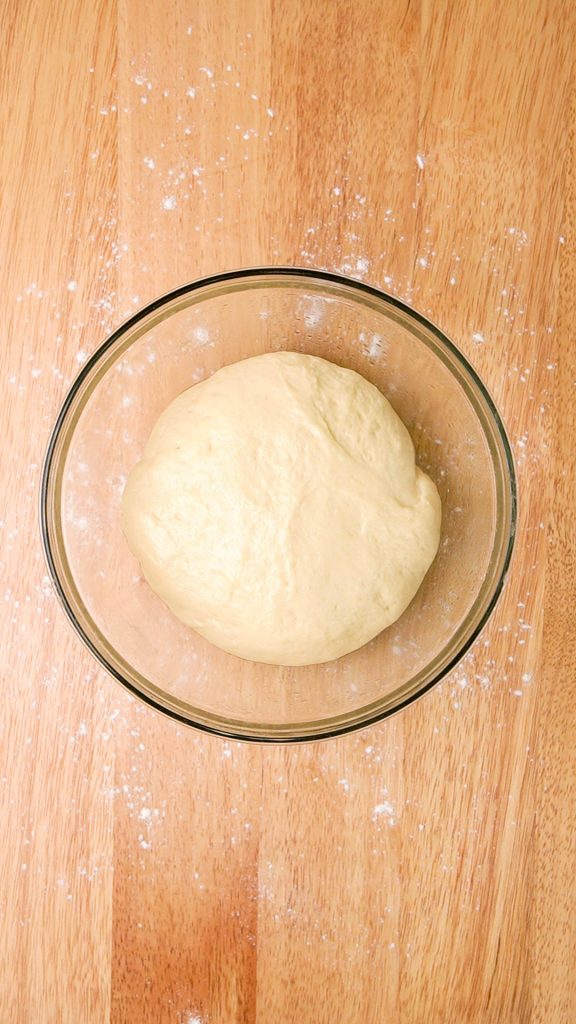
2. Mix the Main Donut Dough
For the donut dough, stir glutinous rice flour, baking powder, granulated sugar, matcha powder, melted butter, egg, milk, and starter dough in a stand mixer. You can also use a hand mixer if that’s all you’ve got.
Then, stir your flour mixture on low speed until everything is well combined. The dough should be wet and sticky, but it shouldn’t cling to your hands. If it’s too sticky, add teaspoons of milk as needed.
3. Roll the Dough Into a Donut
After getting the right consistency, it’s time to roll the dough. Here are two ways you can form your dough.
Dough Ball Version
Dust a clean surface with glutinous rice flour and place your dough on it. Then, cut the dough into four equal sections and roll each piece into a tube. The thickness depends on your preference, but I recommend making tubes with ½-inch to 1-inch thickness.
Then, cut the tubes into equal pieces. Next, grab a piece of dough, and roll it into a ball using your hands. Once you’re satisfied with the dough’s shape and size, place it on a plate dusted with glutinous rice flour.
This recipe should yield up to 60 dough balls.
Pon de Ring Version
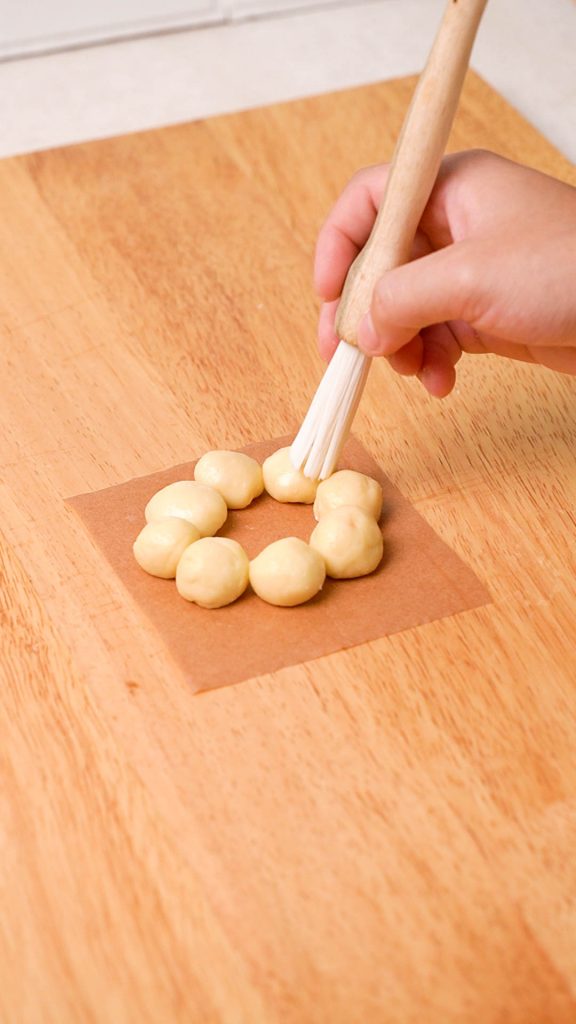
You must complete the dough ball version to make the Pon de Ring version. After you’ve rolled enough dough balls, form a circle using six to eight balls on a piece of parchment paper. The number of dough balls depends on how big you want your donuts.
Make sure each piece touches the other and creates a hole in the middle, like a standard donut. Repeat these steps until you’ve used up all your dough balls.
If you don’t want to roll the dough by hand, some recipes put the dough in a piping bag and squeeze small dough balls in a ring shape on parchment paper to form a Pon de Ring. It might be challenging to squeeze the dough out since it’s thick, but it’s worth a try.
Tip: For the parchment paper, cut it into squares or circles the size of a donut before placing the dough on top. The paper will help form uniform donuts and make it easy for you to fry them one by one later.
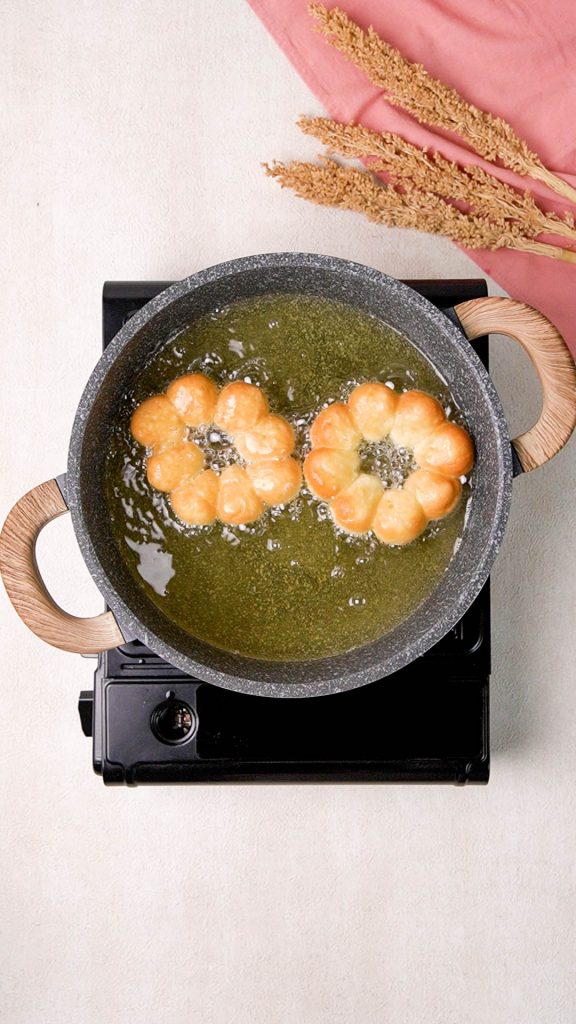
4. Fry the Mochi Donuts
Heat vegetable oil in a pan or deep fryer, and aim for an oil temperature of 330°F or 165°C. Once it reaches that temperature, deep fry your donuts in batches.
If you made a Pon de Ring version, I usually add the donuts into the oil while they’re still on the parchment paper. The parchment paper helps keep the ring shape intact as it fries. After around 30 seconds, you can remove and discard the paper.
When frying mochi donuts, I avoid crowding the pot to prevent the donuts from sticking to each other ( I use this same technique with lumpia wrappers). I also rotate them as needed to cook the dough evenly. Once the dough puffs up and shows a light golden brown color, it’s ready to be taken out.
Transfer the fried donuts to a cooling rack and let them cool at room temperature before putting the finishing touches. If you don’t have a wire rack, you can place the donuts on a paper towel stack to cool the donuts and absorb the excess oil.
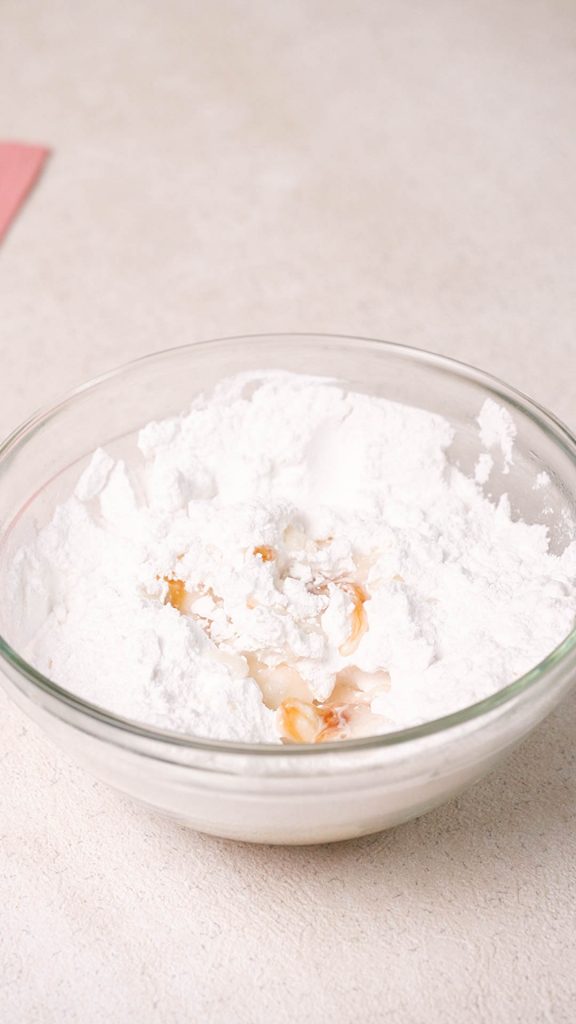
5. Whisk the Glaze
Mix your dry ingredients in a small bowl to make the matcha glaze. This includes the confectioners’ sugar and matcha powder. Then, add your wet ingredients, such as vanilla extract, milk, and lemon juice.
Whisk everything until you get a smooth, thick glaze. If it’s too thick, you can add more milk, a teaspoon at a time, until it’s at the right thickness. It should have a runny consistency when flowing from a spoon, but feel free to adjust the glaze according to your desired thickness.
Note that making this matcha glaze is optional, depending on your preferred topping. However, it’ll add more flavor and depth to your donuts, especially if you’re making the Pon de Ring version.
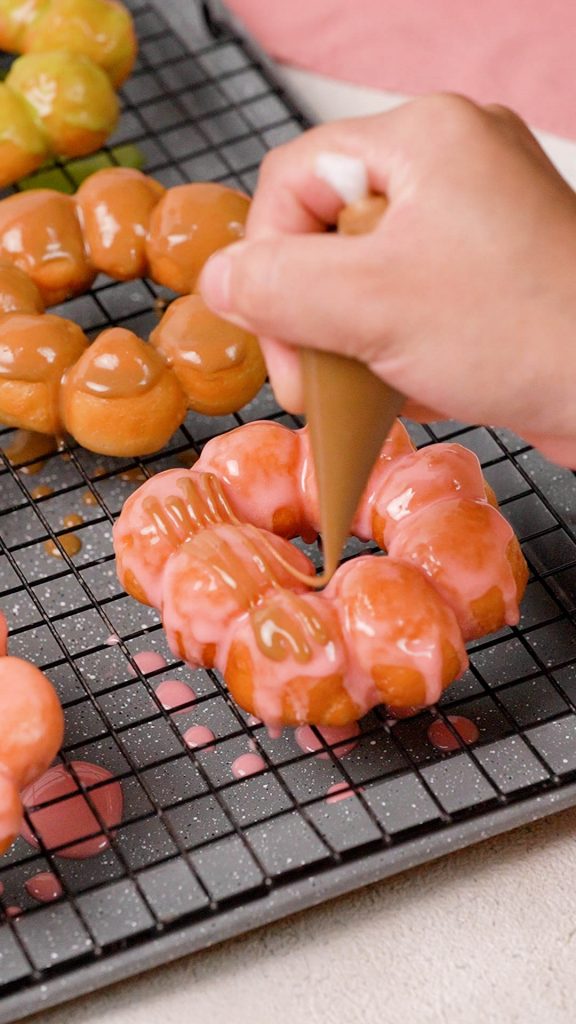
6. Finish and Serve
Before serving, let’s finish with some toppings. We already made the glaze, so let’s make the dusting sugar by combining the powdered sugar and the matcha powder.
Once your donuts cool down, you can either top them off with the matcha sugar dusting or dip the donuts in the matcha glaze. If you decide to do both methods, dip your mochi donuts in the icing and then finish it with the powder. Before serving, let the glaze dry and harden for a few minutes at room temperature.
When you’re all set, immediately serve these homemade matcha mochi donuts and pair them with your favorite tea, coffee, or drink.
Frequently Asked Questions
What Is Mochi?
Mochi is a Japanese rice cake confection popular for its sticky, stretchy, and chewy texture. It’s traditionally made from pounded and molded mochigome, a short-grain Japanese glutinous rice. However, most recipes use mochiko, a glutinous rice flour milled from the mochigome rice, since it’s easier and quicker to make.
Overall, mochi is a versatile dessert, offering a variety of forms and flavors. Some popular mochi treats include mochi stuffed with sweet red bean paste, sakura mochi, and butter mochi (a Hawaiian baked cake). Meanwhile, one of the most popular forms of mochi in the U.S. is pastel-colored ice cream stuffed mochi.
What Are Mochi Donuts?
Also known as ‘mochinut’ or ‘poi mochi,’ mochi donuts are a fusion of Japanese mochi and American donuts. Thanks to the sticky rice flour in the recipe, they offer a chewy donut texture and are gluten-free.
Mochi donuts have only recently started to become popular in the West, but they’ve long been eaten in Japan. Mister Donut popularized the mochi donut, using the name Pon de Ring, in the early 2000s. Today, it’s usually made with eight small balls shaped into a ring.
What Do Mochi Donuts Taste Like?
The mochi donuts’ dough offers a subtle, sweet taste similar to the traditional mochi. However, its taste ultimately depends on the icing or topping.
The most common recipes dip the donuts in a simple sugar glaze or matcha glaze, like our recipe above. Other popular toppings include black sesame seeds, cinnamon sugar, and chocolate glaze with rainbow sprinkles.
When it comes to its texture, this donut is known for its chewiness. It’s different from the doughy chew you get from a regular donut. Instead, it’s more soft and fluffy at the bite, similar to eating a marshmallow. Also, the dough has a crisp and golden brown exterior, which complements its springy center.
What Is Mochi Donut Made Of?
Many recipes use different ingredients to produce their version of mochi donuts. In general, it’s made from a mix of any of these ingredients:
- Glutinous sweet rice flour or mochiko
- Gluten-free tapioca flour or tapioca starch
- Baking powder
- Cornstarch
- All-purpose flour
- Silken tofu
- Granulated sugar
- Egg
- Milk
- Water
Most recipes commonly use glutinous rice flour to produce the mochi donut’s signature chewy and dense consistency. However, some use tapioca starch to give the donut a light and fluffy texture. A few recipes even use both to achieve a middle ground.
Meanwhile, the most popular flavors for the icing or glaze are a basic sugar glaze, matcha glaze, and Nutella glaze. Some even make a strawberry glaze from melted white chocolate and fresh strawberries. Many people also prefer classic toppings like matcha powder, powdered sugar, and white chocolate chips.
What Is Silken Tofu?
Silken tofu is a kind of tofu known for its silky appearance and delicate texture. This is achieved by coagulating the soy milk without curdling it and leaving the tofu unpressed. As a result, you get a smooth surface that can fall apart quickly.
The recipe above didn’t call for silken tofu for convenience. Still, many recipes incorporate silken tofu for that extra chew and bounce.
What Is Mochiko?
Mochiko is a finely-powdered, sweet rice flour made from the short-grain Japanese glutinous rice called mochigome. It’s often used to make various Japanese pastries and sweets and as a gluten-free thickener.
Interestingly, mochiko is also used in other cuisines, like Chinese dim sum, Filipino rice cake confections, Korean desserts, and Hawaiian cakes and sweets. Outside of these cuisines, it’s used as a thickener and coating for fried dishes.
Can I Use Normal Rice Flour to Make Mochi Donuts?
No. You must use glutinous rice flour to achieve that chewy, sticky, and stretchy texture the donut’s known for.
You can’t substitute sticky rice flour with all-purpose flour, either. You can try adding all-purpose flour to your mix, but it won’t produce the mochi’s signature texture.
It’s best to use mochiko since it’s the most common ingredient when making mochi donuts. You can find it online or at any Asian grocery store.
If you can’t find mochiko anywhere, you can use tapioca flour or tapioca starch, which are actually the same thing. But note that this alternative ingredient will give a milder taste and lighter texture while maintaining the donut’s chewiness.
Shiratamako, a sweet rice flour, also works as a substitute if you can’t buy mochiko or tapioca flour. However, it’s pretty expensive and harder to find in supermarkets.
How Are Mochi Donuts Different From Normal Donuts?
Mochi donuts differ from regular donuts in terms of texture and ingredients. They’re made of glutinous rice flour, which produces a soft, chewy texture like a mochi. Some recipes also include silken tofu to add more chew to the dough. Meanwhile, regular donuts use all-purpose flour to achieve a light and airy texture with less chewiness.
What’s the Difference Between Mochi Donuts and Pon de Ring Donuts?
Although many link mochi donuts and Pon de Ring donuts, both are different from each other, despite their similar appearance and chewiness.
When it comes to the main ingredient, mochi donuts use glutinous rice flour. In contrast, Pon de Ring donuts use wheat flour and tapioca flour, as officially stated by Mister Donut.
In terms of texture, both are chewy. However, the mochi donut has a denser consistency, while the Pon de Ring has a lighter texture.
One last difference is that mochi donuts are famous in the West but not sold in Japan. Meanwhile, the Pon de Ring is a popular menu item by Mister Donut in Japan. Many say you can tell the two donuts apart once you’ve tried both.
Are Mochi Donuts Healthier Than Regular Donuts?
Compared to regular donuts, mochi donuts contain fewer calories and are gluten-free, making them a healthier alternative. However, deep-frying them can’t be considered entirely healthy. If you’re health conscious, it’s best to bake them instead.
How Many Calories Do Mochi Donuts Contain?
One mochi donut contains about 220 calories, depending on the exact measurements and recipe. Meanwhile, one regular medium-sized donut provides 190-300 calories. In general, mochi donuts contain fewer calories than regular donuts.
How Do You Store Mochi Donuts?
Mochi donuts should be eaten as soon as they are made. After all, they’re best when they’re fresh.
However, if you need to save them later, store them in an airtight container at room temperature for up to 24 hours. When you’re ready to consume them, put the donuts in a microwave for 10-20 seconds before eating.
You can also freeze the donuts after they’re cooked. Before freezing them, cool them down completely before placing them inside an airtight container and into the freezer. Generally, they can last for a month or two when frozen.
Enjoy This Mochi Donuts Recipe!
Whenever I get my hands on glutinous rice flour, this mochi donuts recipe is my go-to snack for a fast, filling, and flavorful dessert. This matcha version pairs well with a hot or cold drink, making it a perfect indulgent treat. Also, this recipe is quick and easy, so you can easily make it in your kitchen!
Feel free to adjust the recipe according to your preferences or dietary needs. However, I hope you try this recipe and let me know your take on this chewy donut.
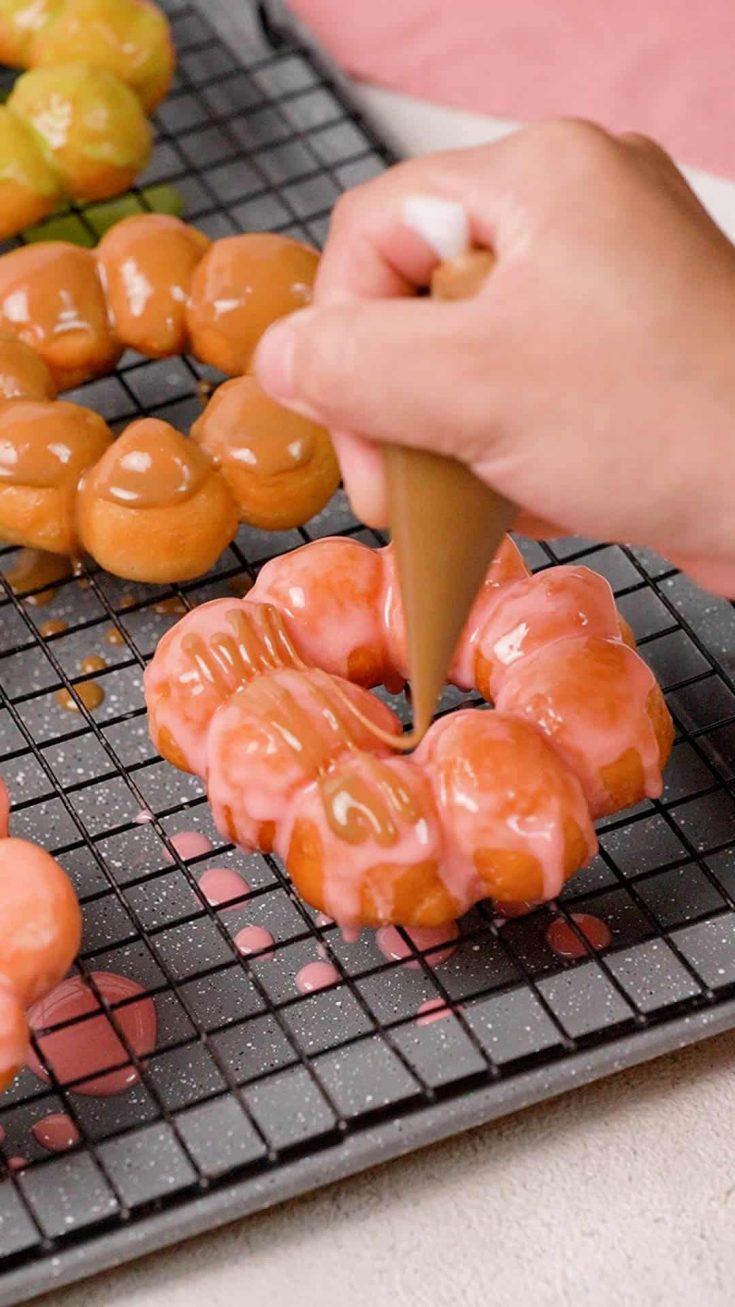
Mochi Donuts
Is there anything better than mochi donuts? These chewy, sweet treats are so sweet and delicious you won't be able to stop eating them! Treat yourself to a box today!
Ingredients
Dough
- 3 Tbsp unsalted butter
- 1 large egg, beat well
- 1⁄2 cup warm whole milk
- 1 tsp instant yeast
- 1⁄4 teaspoon baking powder
- 1⁄4 cup granulated sugar divided
- 1⁄2 tsp pure vanilla extract
- 1 cup cornstarch
- 1 cup and 2 tbsp all-purpose flour
- 1⁄4 tsp salt
- neutral cooking oil vegetable oil preferred
Glaze:
- 2 cups powdered sugar
- 1⁄4 cup whole milk
- 1⁄2 tsp pure vanilla extract
- Matcha Pasta
- Strawberry Pasta
- Chocolate Pasta
Instructions
Make the Donuts
- Add 1 tbsp of sugar, milk, and instant yeast to a bowl, mix well and cover with a kitchen
towel. Let rest for 10 minutes or until its bubbles. - Prepare a large mixing bowl, sift cornstarch, 1 cup of the all-purpose flour, baking
powder, and salt then whisk it until incorporated. Set aside. - In the bowl of a stand mixer with a paddle attachment, add the rest of the sugar, beaten
egg, vanilla, and milk mixture. Beat on low speed on low speed for 2 minutes. - Add the flour mixture in 3 parts to the bowl. Until the dough has thickened. After all the
flour mixture has been added, add the butter and mix for 5 minutes or until smooth. The
dough should be sticky and stretchy when you remove the flat beater from the mixer. - Prepare a clean large mixing bowl. Add a little oil and grease it with a paper towel. We
don't want the dough too oily. - Gently scrape all the dough and put it into the greased bowl. Cover with a warm damp
kitchen towel and let it rise for 60 minutes or double in size. - After proofing, scrape the dough onto the floured flat surface. Sprinkle some flour on the
top of the dough and press down the dough to release any bubbles. You have to flour
your hand too in this step. - Weigh the dough 40 grams each and take 1 small dough to shape it. While you shape 1
dough, don't forget to cover the others dough with a kitchen towel. - You can shape the mochi donut as you like but here is how I shape mine. Divide the 40 grams of dough into 8 small balls (around 5 grams each) and round it between your hand.
- On the square of parchment paper, arrange the 8 small balls of dough into a ring. It will look like a flower. Make sure every ball sticks really well to each other.
- To make sure the balls won’t separate in the oil, use a pastry brush to dab water on the dough where each ball attaches to the other. Cover the donuts with a damp paper towel (you have to use a light one) and allow them to rest for 15-20 minutes. Continue with the rest of the dough.
- Time to fry! Heat oil in a deep skillet or deep fryer. Carefully place the donut with the parchment paper into the hot oil. You can use a flat strainer or flat spatula to help you.
- Fry the donut for 45s or until light brown. Flip and take the parchment paper out from the hot oil using tongs or chopsticks. Drain on the tray with some paper towels.
Make the glaze
- In a medium bowl, mix 2 cups powdered sugar and 1⁄2 tsp pure vanilla extract. Add the
milk little by little until desired thickness. - Separate the glaze into 3 bowls and add the pasta as you like.
- Dip the donut into the glaze and enjoy!

